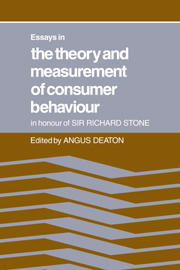Book contents
- Frontmatter
- Contents
- Foreword
- List of contributors
- Part one The analysis of commodity demands
- Part two The theory of index numbers
- Part three The consumption function and durable goods
- Introduction
- 8 Testing neoclassical models of the demand for consumer durables
- 9 Liquidity and inflation effects on consumers' expenditure
- Part four Other aspects: fertility and labour supply
- Bibliography of Sir Richard Stone's works 1936–79
- Index of names
- Subject index
8 - Testing neoclassical models of the demand for consumer durables
Published online by Cambridge University Press: 05 November 2011
- Frontmatter
- Contents
- Foreword
- List of contributors
- Part one The analysis of commodity demands
- Part two The theory of index numbers
- Part three The consumption function and durable goods
- Introduction
- 8 Testing neoclassical models of the demand for consumer durables
- 9 Liquidity and inflation effects on consumers' expenditure
- Part four Other aspects: fertility and labour supply
- Bibliography of Sir Richard Stone's works 1936–79
- Index of names
- Subject index
Summary
Introduction
Modelling the demand for consumer durables is not one of the easiest topics in applied economics. Much of the most creative work in the field was done in Cambridge in the 1950s in the group around Stone. Thus the classic paper by Farrell (1954) was the first systematic application of discrete choice theory to the problem and made a notable contribution also in analysing the interaction of the markets for new and used cars. Under the direct influence of Stone, Cramer (1957), in another classic, first put forward a neoclassical model integrating the demand for durable and non-durable goods with the life cycle theory of Ramsey (1928), Fisher (1930), Tintner (1938) and Modigliani and Brumberg (1955). The essence of the model lies in the assumptions that the budget constraint is linear and known with confidence and that, in efficiency-corrected units, new and used durables are perfect substitutes. Stone and Rowe (1957) simultaneously with Chow (1957) first applied the stock adjustment model to the demand for durables. The latter remains the most popular tool of analysis for aggregate time-series data though more recently Smith (1974; 1975) and Westin (1975) have put forward the ‘discretionary replacement’ model as a simple alternative. Though the neoclassical model of investment has been widely applied since Haavelmo (1960) and Jorgenson (1963), application to consumer durables have been less frequent. Diewert (1974) is one and contains a useful discussion of the theory.
- Type
- Chapter
- Information
- Essays in the Theory and Measurement of Consumer Behaviour: In Honour of Sir Richard Stone , pp. 213 - 236Publisher: Cambridge University PressPrint publication year: 1981
- 3
- Cited by



